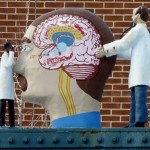When I think of recovery from a terrible illness, I think of Reynolds Price. His beautiful memoir, A Whole New Life, records the powerful experience of his mental and spiritual healing from the excruciating pain of a crippling illness. Though his success in overcoming debilitating pain may seem far removed from the problems of depression, the methods he used – biofeedback and hypnosis – can also be powerful tools for the treatment of depression.
The condition he has had to live with is a form of spinal cancer that has left him a paraplegic for life.
Most of the memoir records his painful struggles of the disease’s crippling progress. After surgery to relieve the tumor’s pressure on the major nerves emanating from the spine, he gradually lapsed into paralysis. He also endured a brutal course of intense radiation treatment that burned and scarred a great deal of tissue. Eventually, he lost all use of his lower body and became dependent on full-time attendants. His muscles began the unpredictable spastic leaps that have continued from that time on.
But the worst and most unrelenting problem was a scalding pain that became his constant companion.
There were … hours in which I dwelt on the steep and constant rise in a pain that had many times seemed as high as I could bear. Whatever the cause … the searing burn down the length of my spine and across my shoulders and the jolting static in both my legs only soared in intensity. Like most real agony, the pain afflicted more senses than one; it often shined and roared as it burned. More than once I panicked in the glare and noise.
The initial treatment for his pain consisted entirely of drugs, from morphine through a series of antidepressants, steroids and the often addictive methadone, regularly used at that time as an alternate to heroin in treating drug addicts. Not one of these helped his pain, but as often happens, he continued taking many of them anyway. He also tried the visualization techniques originated by Carl Simonton, a pioneer in the mind-body connection approach to the treatment of cancer. His Getting Well Again is a classic description of self-help techniques based on this method. Isolating visualization from the other dimensions of that approach, however, didn’t work for Price.
It was only after three years of constant pain that Price began working with the Duke research program on pain prevention and management. He started with biofeedback training that helped him develop abilities to concentrate his thought on specific parts of his body to eliminate tension and pain. After mastering those skills, he worked with a psychiatrist who was an expert in the use of deep hypnosis. That was the answer. As someone susceptible to hypnotic trances, Price found these experiences completely successful in relieving all his pain. He mastered the techniques well enough to be able to counter recurrences – largely because he had a completely different mental and emotional response to what he felt as pain.
He is quick to point out that these treatments would not necessarily work for everyone as well as they did for him. That is partly due to his own receptivity to biofeedback and hypnosis, which is not the same for everyone, but also partly to the particular nature of his pain. And that factor deepens the relevance of Price’s experience to the treatment of long-term depression.
His pain did not have any immediate physical cause.
The ultimate cause, of course, was the cancer that had broken the connection between his brain and his lower body. The now useless nerve endings then died and with them went any possibility of transmitting those signals that the mind interprets as pain. The agony that he experienced resulted entirely from the mind’s attempt to compensate for the loss of information from the lower body. It produced the same phantom pain that amputees often experience as coming from a missing limb.
What enabled him to make this breakthrough? Here is a brief excerpt from his interpretation.
With all its powers, my mind can make no significant physical amends to me for the permanent wreckage done to my spine … . The causes [of pain] are past yet the panicked alarm continues to blare. The mind’s only hope for sanity then is to shut down the useless but frantic circuits and look elsewhere for ease and continuance. In the summer of ’87, my mind was finally ready for that action. … It had desperately needed to hear and believe that the unending stream of neural alarm meant nothing now. The need had been filled. Now my mind understood that The harm is done. It cannot be repaired; pain signifies nothing. Begin to ignore it.
Few of us who’ve lived with chronic and severe depression can imagine achieving a degree of mental control that would lead to the end of that dark dominance over both thinking and feeling. And with the current emphasis on the neurobiological causes of depression, the possibility seems remote. Yet deep meditation and many non-western traditions are based on the mind’s power to effect just such healing.
As a layman, I think of it this way. Depression, similar to pain, is not a physical phenomenon in itself but a psychological response that corresponds somehow to changes in the brain’s neurobiology and circuitry. Whatever might be going on in the brain is shaped by the mind into experiences of despair, worthlessness, fear, obsessiveness and the rest. It seems reasonable to me that the mind could retrain itself to identify different responses to the same signals from the body’s neural circuitry. As happened to Price, the mind can, in some cases, defuse the power of pain by refocusing its activity. The same signals of pain persisted in his body, but they were no longer the center of his attention or concern.
These thoughts occur to me as I read Price’s account of his healing partly because I’m trying to figure out my own experience of recovery – which has gone far beyond the effects of any medication I’ve ever taken. Even though I never found a single method to follow in an intensive way, my mind has, in fact, come up with a completely different approach to the experience of depression. The question I ask myself is the same one Price asked. Why now? I had been doing more or less the same things for years without much success, but then everything fell into place. That’s one of the aspects of recovery that makes it such a unique experience for everyone who manages to get that far.
What do you think about changing the mind’s orientation toward depression, as Price changed his toward pain?
Reynolds Price died on January 20, 2011, at the age of 77. After his cancer set in in 1984, he produced an average of more than one book a year, completing as many in the next 10 years as he had during the previous 20.





“Why now? I had been doing more or less the same things for years without much success, but then everything fell into place. That’s one of the aspects of recovery that makes it such a unique experience for everyone who manages to get that far. ”
Your words inspires me. I still hope for that momente when “then everything fell into place”
Thanks John
Hi, Javier –
Here’s hoping that day will come soon.
John